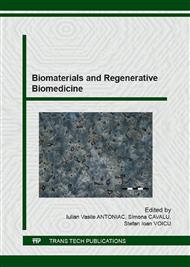[1]
Kumar P, Vinitha B, Fathima G. Bone grafts in dentistry. J Pharm Bioallied Sci. 2013 Jun; 5(Suppl 1): S125-7.
DOI: 10.4103/0975-7406.113312
Google Scholar
[2]
Browaeys H, Bouvry P, De Bruyn H. A literature review on biomaterials in sinus augmentation procedures. Clin Impl Dent Rel Res 2007, 9: 166-177.
DOI: 10.1111/j.1708-8208.2007.00050.x
Google Scholar
[3]
Bauer TW, Muschler GF. Bone graft materials: an overview of the basic science. Clin Orthop. 2000; (371): 10-27.
Google Scholar
[4]
Panagiotou D, Özkan Karaca E, Dirikan İpçi Ş, Çakar G, Olgaç V, Yılmaz S Comparison of two different xenografts in bilateral sinus augmentation: radiographic and histologic findings. Quintessence Int. 2015 Jul-Aug; 46(7): 611-9.
Google Scholar
[5]
de Lange GL, Overman JR, Farré-Guasch E, Korstjens CM, Hartman B, Langenbach GE, Van Duin MA, Klein-Nulend J. A histomorphometric and micro-computed tomography study of bone regeneration in the maxillary sinus comparing biphasic calcium phosphate and deproteinized cancellous bovine bone in a human split-mouth model. Oral Surg Oral Med Oral Pathol Oral Radiol. 2014 Jan; 117(1): 8-22.
DOI: 10.1016/j.oooo.2013.08.008
Google Scholar
[6]
Tadi DP, Pinisetti S, Gujjalapudi M, Kakaraparthi S, Kolasani B, Vadapalli SH. Evaluation of initial stability and crestal bone loss in immediate implant placement: An in vivo study. J Int Soc Prev Community Dent. 2014 Sep; 4(3): 139-44.
DOI: 10.4103/2231-0762.142002
Google Scholar
[7]
Hamdy RM, Abdel-Wahed N. Three-dimensional linear and volumetric analysis of maxillary sinus pneumatization. J Advanc Res. 2014 May; 5(3): 387–395.
DOI: 10.1016/j.jare.2013.06.006
Google Scholar
[8]
Lagravère MO, Carey J, Toogood RW, Major PW. Three-dimensional accuracy of measurements made with software on cone-beam computed tomography images. Am J Orthod Dentofacial Orthop. 2008 Jul; 134(1): 112-6.
DOI: 10.1016/j.ajodo.2006.08.024
Google Scholar
[9]
Kim ES, Moon SY, Kim SG, Park HC, Oh JS. Three-dimensional volumetric analysis after sinus grafts. Implant Dent. 2013 Apr; 22(2): 170-4.
DOI: 10.1097/id.0b013e31827f3576
Google Scholar
[10]
Mazzocco F, Lops D, Gobbato L, Lolato A, Romeo E, del Fabbro M. Three-dimensional volume change of grafted bone in the maxillary sinus. Int J Oral Maxillofac Implants. 2014 Jan-Feb; 29(1): 178-84.
DOI: 10.11607/jomi.3236
Google Scholar
[11]
Shanbhag S, Shanbhag V, Stavropoulos A. Volume changes of maxillary sinus augmentations over time: a systematic review. Int J Oral Maxillofac Implants. 2014 Jul-Aug; 29(4): 881-92.
DOI: 10.11607/jomi.3472
Google Scholar
[12]
Fienitz T, Schwarz F, Ritter L, Dreiseidler T, Becker J, Rothamel D. Accuracy of cone beam computed tomography in assessing peri-implant bone defect regeneration: a histologically controlled study in dogs. Clin Oral Implants Res. 2012 Jul; 23(7): 882-7.
DOI: 10.1111/j.1600-0501.2011.02232.x
Google Scholar
[13]
Brezinski ME, Optical coherence tomography: principles and applications, Academic Press, Burlington, 2006, 3–29.
Google Scholar
[14]
Christoph Kasseck, Marita Kratz, Antonia Torcasio, Nils C. Gerhardt, G. Harry van Lenthe, Thilo Gambichler, Klaus Hoffmann, David B. Jones, Martin R. Hofmann. Optical Coherence Tomography versus Micro Computer Tomography. Proceedings of SPIE - The International Society for Optical Engineering 07/(2009).
DOI: 10.1364/ecbo.2009.7372_1b
Google Scholar
[15]
Antonie S., Sinescu C., Negrutiu M., Sticlaru C., Negru R., Laissue P. L., Rominu M., Podoleanu A. G., Investigation of Implant Bone Interface with Non-Invasive Methods: Numerical Simulation, Strain Gauges and Optical Coherence Tomography, Key Engineering Materials, Vol. 399, pp.193-198, Oct. (2008).
DOI: 10.4028/www.scientific.net/kem.399.193
Google Scholar
[16]
Negruţiu M., Sinescu C., Canjau S., Manescu A., Topală F., Hoinoiu B., Romînu M., Mărcăuţeanu C., Duma V., Bradu A., Podoleanu A. Bone regeneration assessment by optical coherence tomography and MicroCT synchrotron radiation. Proc. SPIE 8802, Optical Coherence Tomography and Coherence Techniques VI, 880204 (June 18, 2013).
DOI: 10.1117/12.2032624
Google Scholar
[17]
Sinescu C, Negrutiu M, Tatar R, Terteleac A, Negru R, Hluscu M, Culea L, Rominu M, Marsavina L, Hughes M, Bradu A, Dobre Gm, Marcauteanu C, Demjan E, Podoleanu A, Investigation of osteoconductive bone substitute by particles analysis, numerical simulation and optical coherence tomography, Lasers In Dentistry XV, Book Series: Proceedings of SPIE-The International Society for Optical Engineering, Volume: 7162, Article Number: 716207, (2009).
DOI: 10.1117/12.809688
Google Scholar
[18]
Rokn AR, Khodadoostan MA, Reza Rasouli Ghahroudi AA, Motahhary P, Kharrazi Fard MJ, Bruyn HD, Afzalifar R, Soolar E, Soolari A. Bone formation with two types of grafting materials: a histologic and histomorphometric study. Open Dent J. 2011; 5: 96-104.
DOI: 10.2174/1874210601105010096
Google Scholar
[19]
Lee du H, Yang KY, Lee JK. Porcine study on the efficacy of autogenous tooth bone in the maxillary sinus. J Korean Assoc Oral Maxillofac Surg. 2013 Jun; 39(3): 120-6.
DOI: 10.5125/jkaoms.2013.39.3.120
Google Scholar
[20]
de Avila ED, Filho JS, de Oliveira Ramalho LT, Real Gabrielli MF, Pereira Filho VA. Alveolar ridge augmentation with the perforated and nonperforated bone grafts J Periodontal Implant Sci. 2014 Feb; 44(1): 33–38.
DOI: 10.5051/jpis.2014.44.1.33
Google Scholar
[21]
Ghanaati S, Barbeck M, Lorenz J, Stuebinger S, Seitz O, Landes C, Kovács AF, Kirkpatrick CJ, Sader RA. Synthetic bone substitute material comparable with xenogeneic material for bone tissue regeneration in oralcancer patients: First and preliminary histological, histomorphometrical and clinical results. Ann Maxillofac Surg. 2013 Jul; 3(2): 126-38.
DOI: 10.4103/2231-0746.119221
Google Scholar
[22]
Mahmoud-A. Shalash , Hatem-A. Rahman, Amr-A. Azim , Amani-H. Neemat , Hesham-E. Hawary, Sherine-A. Nasry. Evaluation of horizontal ridge augmentation using beta tricalcium phosphate and demineralized bone matrix: A comparative study. J Clin Exp Dent. 2013; 5(5): e253-9.
DOI: 10.4317/jced.51244
Google Scholar
[23]
Lee JH, Ryu MY, Baek HR, Lee KM, Seo JH, Lee HK. Fabrication and evaluation of porous beta-tricalcium phosphate/hydroxyapatite (60/40) composite as a bone graft extender using rat calvarial bone defect model. ScientificWorldJournal. 2013 Dec 17; 2013: 481789.
DOI: 10.1155/2013/481789
Google Scholar
[24]
Oryan A, Alidadi S, Moshiri A, Maffulli N. Bone regenerative medicine: classic options, novel strategies, and future directions. J Orthop Surg Res. 2014 Mar 17; 9(1): 18.
DOI: 10.1186/1749-799x-9-18
Google Scholar
[25]
de Lange GL, Overman JR, Farré-Guasch E, Korstjens CM, Hartman B, Langenbach GE, Van Duin MA, Klein-Nulend J. A histomorphometric and micro-computed tomography study of bone regeneration in the maxillary sinus comparing biphasic calcium phosphate and deproteinized cancellous bovine bone in a human split-mouth model. Oral Surg Oral Med Oral Pathol Oral Radiol. 2014 Jan; 117(1): 8-22.
DOI: 10.1016/j.oooo.2013.08.008
Google Scholar


